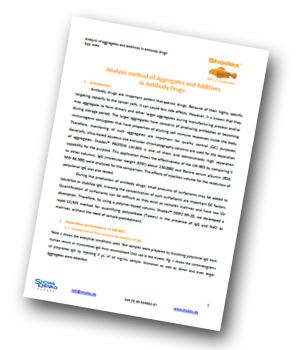Shodex advanced HPLC columns has produced an application note describing the analysis of aggregates and additives in antibody drugs, using different kinds of size-exclusion columns.

 Introduction
Introduction
Antibody drugs are important therapeutic drugs that, because of their highly specific targeting capacity to the cancer cells, can cause fewer side effects. However, it is known that they may aggregate to form dimers and other larger aggregates during the manufacturing process and/or during the storage period. Monitoring of such aggregates is important for quality control (QC) purposes.
During the production of antibody drugs, small amounts of surfactants may be added to solubilize or stabilize IgG, so knowing the concentration of such surfactants is an important QC factor. Quantification of surfactants can be difficult as they exist as complex matrixes and have low UV absorption. Therefore, by using a polymer-based reversed-phase column, Shodex™ ODP2 HP-2D, a rapid LC/MS method for quantifying polysorbate (Tween) in the presence of IgG and NaCl as matrixes was developed without the need of sample pre-treatment.
Methods
In this application note 4 different tests were done.
- Demonstration of separation performance of ShodexTM SEC LW-803 column in comparison with 4 different columns in the analysis of antibody IgG
- SEC analysis and comparison of 3 different columns for BSA protein analysis
- Effect of injection volume in case of antibody analysis of IgG
- Reversed-phase LC/MS analysis of surfactant in antibody drugs (Tween 20 and Tween 80)
Results
Shodex™ PROTEIN LW-803 demonstrated its superior separation capability for IgG monomers and its aggregates. It also has high separation capability including lower molecular weight ranges. This allows the analysis of anti-body metabolites and other proteins. Moreover, the column is capable of handling high loading volumes. Therefore, LW-803 has a wide usability for the separation of not only antibody aggregates but for other proteins.
In contrast, Shodex™ ODP2 HP-2D proved its separation capability of analysing non-ionic surfactant, Tween, in the presence of IgG and NaCl, without the necessity of deproteinization nor desalting sample pre-treatment. Here, alkaline eluent is effective for eluting IgG at V0, which can be only done by polymer-based reverse-phase columns such as ODP2 HP that are durable against alkaline conditions. The method developed in this application is fast and highly-sensitive for the analysis of Tween that has potential in antibody drug QC analysis. Even faster analysis is expected by using a shorter column (50 mm), ODP2
HP-2B, coupled with MS.
The results demonstrated that high abundance of carotenoids in flesh was the characteristic feature inherited by species and strains in the taxonomic tree of Citrus unshu (Satsuma/Mikan) and Citrus reticulate (Mandarin orange). Such indication may be useful in making a strategic approach to developing a new strain with better characteristics.